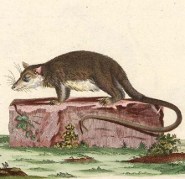 The Bare-tailed woolly opossum (Caluromys philander), is a mammal aptly named for its hairless, prehensile tail.
The Bare-tailed woolly opossum (Caluromys philander), is a mammal aptly named for its hairless, prehensile tail.Native to Bolivia, Brazil, French Guiana, Guyana, Suriname, Trinidad and Tobago, and Venezuela, the Bare-tailed woolly opossum is primarily found in arboreal habitats, usually neotropical forests. This nocturnal animal spends its days resting in the canopy of trees, constructing leaf nests in tree hollows, and foraging at night for food.
The Bare-tailed woolly opossum is a New World marsupial, not to be confused with the Australian marsupial, although both are in the same subclass. The woolly opossum weighs in at less than two-thirds of a pound (.29 kg) and averages eight inches (20 cm) in length. Its tail can be twice as long as its body.
When it comes to diet, Bare-tailed woolly opossums will eat any fruit or flower that they can find. These "food opportunists" will select plants based on availability, rather than nutritional value, and will forage through the canopy of trees looking for easy plants to eat. To grasp a hard-to-reach fruit, the woolly opossum sometimes hangs by its long tail. They also eat seeds, insects, and small invertebrates.
Despite a life span of only three years, breeding does not begin until the female is at least one year old. Gestation is short, usually 14 days or less, with young born premature.
Due to a relatively stable population, the Bare-tailed woolly opossum is not considered endangered. However, its population is decreasing.
Keywords: white , prehensile tail
The Bare-tailed woolly opossum is listed as Near Threatened (LR/nt), is close to qualifying for or is likely to qualify for a threatened category in the near future, on the IUCN Red List of Threatened Species
Namings for the baretailed woolly opossum
A young / baby of a baretailed woolly opossum is called a 'joey'. The females are called 'jill' and males 'jack'.Some facts about the
Woolly opossum
Adult weight : 0.35 kg (0.77 lbs)
Maximum longevity : 9 years
Female maturity :304 days
Gestation : 24 days
Weaning : 100 days
Litter size : 5
Interval between litters : 166 days
Weight at weaning : 0.011 kg (0.0242 lbs)

Custom Search